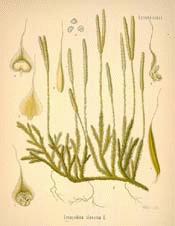

|
Running Clubmoss
(Lycopodium clavatum LINN.)
|
Moss, Common Club
Botanical: Lycopodium clavatum (LINN.)
Family: N.O. Lycopodiaceae
---Synonyms---Muscus Terrestris repens. Vegetable Sulphur. Wolf's Claw.
---Parts Used---The spores, the fresh plant.
This species is found all over the world and occurs throughout Great Britain, being most plentiful on the moors of the northern counties.
Though this species of Club Moss occurs in Great Britain, the spores are collected chiefly in Russia, Germany and Switzerland, in July and August, the tops of the plants being cut as the spikes approach maturity and the powder shaken out and separated by a sieve. Probably the spores used commercially are derived also from other species in addition to Lycopodium clavatum.
---Medicinal Action and Uses---The part of the plant now employed is the minute spores which, as a yellow powder, are shaken out of the kidney-shaped capsules or sporangia growing on the inner side of the bracts covering the fruit spike. Under the names of Muscus terrestris or M. clavatum the whole plant was used, dried, by ancient physicians as a stomachic and diuretic, mainly in calculous and other kidney complaints; the spores do not appear to have been used alone until the seventeenth century, when they were employed as a diuretic in dropsy, a drastic in diarrhoea, dysentery and suppression of urine, a nervine in spasms and hydrophobia, an aperient in gout and scurvy and a corroborant in rheumatism, and also as an application to wounds. They were, however, more used on the Continent than in this country and never had a place in the London Pharmacopoeia, though they have been prescribed for irritability of the bladder, in the form of a tincture, which is official in the United States Pharmacopoeia.
The spores are still medicinally employed by herbalists in this country, both internally and externally, as a dusting powder in various skin diseases such as eczema and erysipelas and for excoriated surfaces, to prevent chafing in infants. Their chief pharmaceutical use is as a pill powder, for enveloping pills to prevent their adhesion to one another when placed in a box, and to disguise their taste. Dose, 10 to 60 grains. They have such a strong repulsive power that, if the hand is powdered with them, it can be dipped in water without becoming wet.
[Top]
Purchase this Herb from Botanical.com
Bear in mind "A Modern Herbal" was written with the conventional wisdom of the early 1900's. This should be taken into account as some of the information may now be considered inaccurate, or not in accordance with modern medicine.
© Copyright Protected 1995-2004 botanical.com

|

